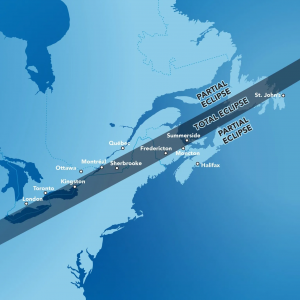During the total solar eclipse on April 8, 2024, the Moon passed between the Earth and the Sun. That Monday afternoon, many in Southern Ontario, Quebec, and the Atlantic provinces witnessed one of the most incredible natural phenomenon we can experience from Earth.
Another total solar eclipse won’t be seen again in Eastern Canada until 2079.
The eclipse was a valuable learning opportunity that connected what students were learning about in their science, math, history, and art classes. It was also an opportunity for people of any age to experience one of the rarest wonders of our solar system around family, friends, and our community members.
At the Dunlap Institute, we are preparing Canadians with free resources, workshops and events, and safe viewing tools.
Eclipse 2024 Livestream: Chasing the Shadow from Niagara to Newfoundland
 No matter where you are in the world on April 8, you can chase the Moon's shadow with us across Canada!
No matter where you are in the world on April 8, you can chase the Moon's shadow with us across Canada!
The Dunlap Institute hosted a livestream with partners across Ontario, Quebec, and the Atlantic provinces to follow the best views of the total solar eclipse.
Watch the archived video to hear from astronomers at the University of Toronto about the science of eclipses, the sounds of space, and important safety tips while watching a dazzling celestial show.
Free eclipse workshops at the Toronto Public Library

We hosted dozens of free workshops across Toronto in partnership with the Toronto Public Library to help attendees safely enjoy the total solar eclipse on April 8 in several different ways!
Astronomers from the University of Toronto will guide participants through making their own pinhole solar viewers, looking at the surface of the sun through telescopes equipped with solar filters, and creating their own scale model of the Earth-Moon-Sun system. Registration information is included on the Toronto Public Library event listings on their website.
Where to get eclipse glasses

Eclipse glasses were available for free at the Toronto Public Library during our workshops or at the circulation desk of any branch starting Wednesday, March 20, 2024, while supplies lasted.
Discover the Universe, with support from the Dunlap Institute, has already distributed over 250,000 eclipse glasses to teachers and schools across Eastern Canada to share with their students. We recommend that children use these glasses with adult supervision.
It was also possible to purchase a pair of eclipse glasses from these certified distributors.
Where and when to see the eclipse

During a total solar eclipse, the Moon completely blocks out the Sun at its maximum. This can only be seen from the path of the Moon's shadow, called the path of totality.
This year, the path of totality will cover well-populated Canadian cities and towns like Hamilton and Kingston in Ontario, Sherbrooke and parts of Montreal in Quebec, Fredericton in New Brunswick, Summerside in Prince Edward Island, and Gander in Newfoundland.
From beginning to end, the eclipse will take about two hours. The eclipse will start, reach its maximum, and end at different times during the afternoon depending on your location.
See timings for the eclipse in different locations across Eastern Canada.
Is it safe to watch an eclipse?
It is completely safe for people of all ages to observe the eclipse while wearing verified eclipse glasses or using indirect viewing methods, like a pinhole viewer.
The Sun is no more or less dangerous to look at during a solar eclipse, and just like any other day, should never be looked directly without the proper protection (sunglasses are not a substitute for verified eclipse glasses).
If you are in the path of totality, you can take off your eclipse glasses to view the eclipse maximum, or when you can no longer see the Sun through your eclipse glasses.
We caught up with Professor Emeritus in Optometry and amateur astronomer Ralph Chou for a closer look at how to safely view an eclipse:
What is a solar eclipse?
A partial or total solar eclipse happens when the Moon crosses in between the Sun and the Earth.
There are two to five solar eclipses somewhere in the world every year. But total solar eclipses occur just once approximately every 18 months.
Solar eclipses are significant in many different cultures around the world. Dunlap Institute Professor Laurie Rousseau-Nepton has brought together Samantha Doxtator and Melanie Demers to explain the importance of the Sun, Moon, and eclipses in Innu, Oneida, and Mohawk cultures.
What you'll see and feel during a total eclipse

As the Moon passes in front of the Sun, the sky will dim and you might notice the temperature cool by a couple degrees.
People in the path of totality will also see some light streaking out from behind the Moon. That is the outer layers of the Sun’s atmosphere, or its corona. At the eclipse maximum, when the Moon is completely covering the Sun, it is safe to remove your eclipse glasses and look directly at the eclipse.
Outside the path of totality, viewers will still see an incredible partial eclipse as the Moon covers a part of the Sun. The further away you are from the path, the less coverage you will see. Even during a partial eclipse, the sky will darken as the Moon blocks parts of the Sun, leaving a sliver of light remaining.
Essential Resources
- Eclipse 2024 Livestream: Chasing the Shadow from Niagara to Newfoundland
- Eclipse workshops at the Toronto Public Library
- Discover the Universe’s resources for educators
- Our call for no kids to be left inside on eclipse day
- University of Toronto eclipse stories
- Where to buy eclipse glasses, solar viewers, and filters
- Royal Astronomical Society of Canada eclipse resources and events
Looking for more information or to speak to an expert at U of T?
